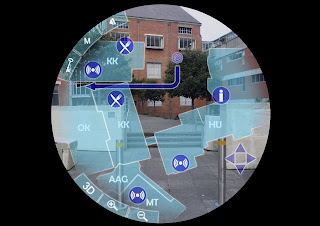Just because it's not due doesn't mean it can't be finished early. Here is a kick*** wire-frame that shows the various functions of my navigational interface. I ran with the peep-hole idea because of how convenient it is to get what you want just by raising your hand to your face, no fumbling around in pockets or scrolling through lists of other applications and most importantly no cybernetic surgery. Because of this anything that would have been a button needs to have a keyword that triggers it, therefore anything bordered by dark blue. The permanent keywords are ones that are forever accessible, regardless of user depth within the interface. All others are only active within the menu (or sub-menu, whatever you want to call them) they are an option for. Blue situation keywords are either keywords set by the user or a fraction of a phrase that has more than one effect e.g. "Zoom 20%" the % value is how close the user wants to zoom to.
Navigate, Timetable, Options and
Store are the four primary fields within the interface and can be access from any of the other fields when their keyword is spoken, as long as one of the field's sub-menus (indicated by the blue boxes surrounding them, e.g. 'Add new' and 'Details' are the sub-menus of
Timetable) has not been selected. In the 'Display Controls' segment all the options, excluding 'Colour', the options are all on/off functions, saying their keyword activating/deactivating them.
The 'Avatar' function would replace remove directional arrows from the screen and instead a holographic character, the default being a green faceless man inspired by the green man crossing symbol, who leads the user forward and talks to them. This would make the travelling more entertaining. As it is unlikely that users would want to walk around with their fingers around their eyes the avatar would have a signal, the default being a whistle, that sounds whenever a corner or alternate route is coming up, indicating the user should check through their peep-hole.
The Peep-hole, as its commercial title shall be from now on considering that's what I keep referring to it as, would be sold as a pair of rings and an earpiece. This would come with the navigational software (as that's what it was originally designed for) but other software would be available for purchase. These programs would include numerous other applications for everyday tasks; personal organisers, banking, socialising (other Peep-hole users could give of visual signals to their location/status/etc.) and so on and so forth, whatever the demand is for. Other, more playful programs would include ones that alter the environment in the alternate cyber world the Peep-hole allows you to see. People who own them could project holographic clothing and characters for others to see. The possibilities are endless. Unfortunately they are a bit beyond the brief but hey, one can dream...













